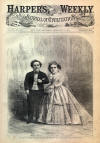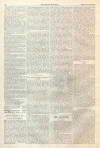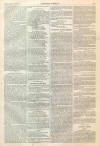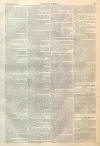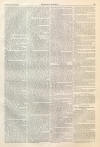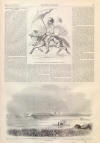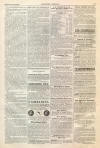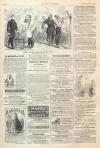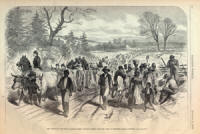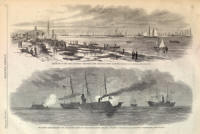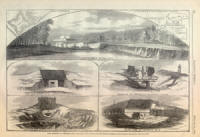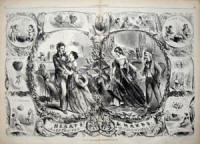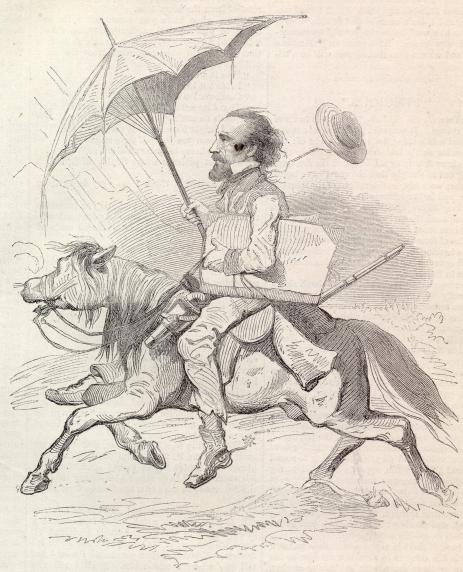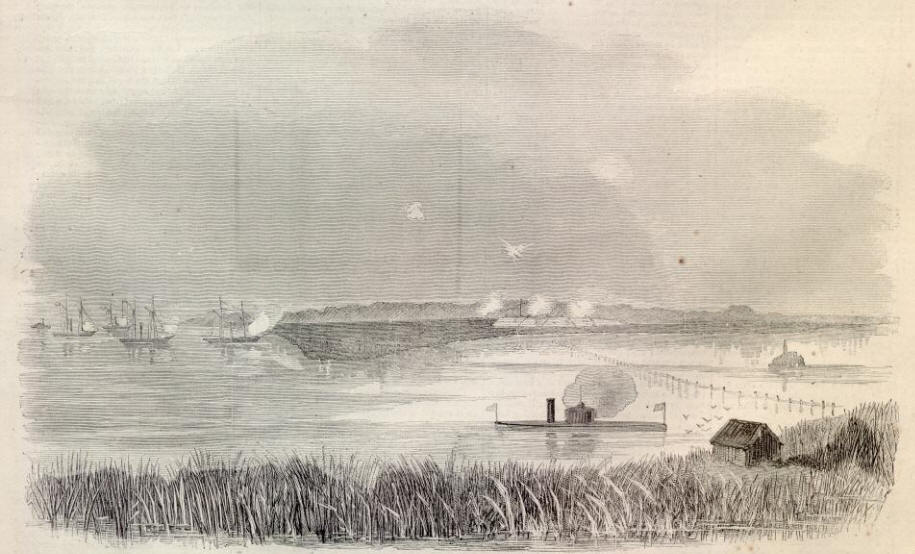|
This Site:
Civil War
Civil War Overview
Civil War 1861
Civil War 1862
Civil War 1863
Civil War 1864
Civil War 1865
Civil War Battles
Confederate Generals
Union Generals
Confederate History
Robert E. Lee
Civil War Medicine
Lincoln Assassination
Slavery
Site Search
Civil War Links
Civil War Art
Mexican War
Republic of Texas
Indians
Winslow Homer
Thomas Nast
Mathew Brady
Western Art
Civil War Gifts
Robert E. Lee Portrait
|
MR. J. ROSS BROWNE, OUR ARTIST "CORRESPONDENT AT
LARGE."
OUR
ARTIST "CORRESPONDENT
AT LARGE."
MR. J. ROSS BROWNE is well known
by name and works to the literary world. His contributions to Harper's Magazine
would fill several volumes. Like most men possessing the faculty of humor, he is
fond of caricaturing himself, and he appears in a variety of questionable
disguises in his own sketches. The above portrait, for which we are indebted to
Mr. Cramer, a young American artist, residing at Frankfort in Germany, barring a
slight touch of caricature, is a capital likeness of the man who visited
Crusoe's Island, discovered Yusef Badra, "The Destroyer of Robbers," traveled
with Doctor Mendoza, "Peeped at Washoe," made a "Dangerous Journey" in
California, visited Norway, Poland, Iceland, Russia, and several other countries
in behalf of Harper's Magazine, where not a few of his varied adventures have
been recorded, and where more, we trust, will be narrated. During more than
twenty years of almost constant travel he has supported himself and a large
family, and made his way in almost every capacity within the limits of human
industry. His journeyings by land and sea amount already to more than six times
around the world—no trifling achievement when we consider the various methods of
travel which he has adopted. Mr. Browne is a native of Ireland. A generation ago
his father was the editor of the Dublin Comet, the leading paper of the day in
Ireland. Taking strong ground against the oppressive acts of the English
Government, his paper was suppressed and he was thrown into prison. A book
written by him called "The Parson's Horn-book," illustrated by Samuel Lover,
gained a wide notoriety, and may even now be met with. The elder Browne was
finally released from imprisonment on condition of leaving the country. He came
to America in 1833, bringing with him his family, among whom was John Ross, then
a mere lad. He struck for the Far West, settled in Indiana, where he established
himself as the owner of a saw-mill and proprietor of a ferry; subsequently he
removed to Louisville, Kentucky, where he became editor of a newspaper, in
connection with which his son's literary faculties received their first definite
impulse.
Mr. Browne commenced his
adventurous career by starting from Louisville, Kentucky, on foot, and making a
tour of several months through the Western States. He made several trading
voyages down the Ohio and Mississippi rivers in the capacity of a common
boatman. At the age of eighteen he became police reporter to the Louisville
Advertiser; then a student in the College of Medicine; and subsequently a
stenographic reporter in Congress. In 1842, having saved up fifteen dollars, he
started for Europe, put up at the Astor House, and got rid of the last remnant
of his money in about two days. He then went down on South Street, saw a sign
calling for whalemen, and shipped on a voyage to the Indian Ocean. Browne was
one of a crew of thirteen men, chiefly Portuguese, and lived in the forecastle,
subject to all the benefits of hard fare and harder labor. During this memorable
voyage he visited the Azores, Cape de Verde, and Canary Islands; Madagascar,
Makumba, and the Comoros; and finally, on the breaking out of a mutiny,
occasioned by cruel treatment of the crew, left the vessel at Zanzibar, near the
East Coast of Africa, and lived for three months among
the Arabs. From Zanzibar he
worked his passage home in a vessel bound to the United States from the Persian
Gulf; and touched on the way at St. Helena, where he paid a visit to Napoleon's
tomb. Of his perilous adventures in the whale-fishery he has given a graphic
account in a narrative published by Harper and Brothers in 1844, entitled
"Etchings of a Whaling Cruise," which has been noticed by the Edinburgh Review
and other English journals in favorable terms.
Resuming his place as a reporter
in the Senate, he followed up his old business till the end of the session, when
he took charge of the books in the office of the Ohio Statesman, at Columbus.
About that time Mr. Robert J. Walker became Secretary of the Treasury and gave
Browne a confidential appointment. This he held until 1849, when he
set sail in a passenger ship for
California, under a commission as a Lieutenant in the Revenue Service. At Rio
Janeiro he was detained some three weeks by a difficulty between the captain and
passengers. A new captain was placed in command, and after many storms and
adversities the ship rounded Cape Horn, and made the Island of Juan Fernandez.
With ten comrades Browne started in an open boat, rowed seventy-six miles, and
landed on the island. His adventures in this "Crusoe Land" were published, with
illustrations, in the February, March, and April numbers of Harper's Magazine
for 1853.
Stopping a couple of weeks at
Lima, in Peru, he reached California in August, 1849, with just sufficient
change in his pockets to pay the postage on a package of letters. One of them
contained notice
of a reduction in the revenue
service and his own removal. While looking around for a situation as washer-man
or mule-driver, he met an influential friend who appointed him a deputy Postal
Agent, and he traveled through the southern part of California in that capacity.
When the Convention met to form the State Constitution, Browne being the only
regular stenographer in the country, was appointed to report the proceedings.
For this job he received ten thousand dollars cash in advance. During the debate
in the United States Senate, relative to the admission of California, it became
necessary to have this report, and the Senate, by resolution, purchased two
thousand copies, for which they paid our lucky adventurer three thousand
dollars. With the fortune thus acquired, he built a handsome house near
Washington, and "retired" for life.
Three months of retirement
answered his purpose. He sold out for cost, pulled up stakes, and started for
Europe. We next find him, by letters to the National Intelligencer, ranging
through Austria, Hungary, the various German States, Italy, Sicily, Greece,
Turkey, and the Holy Land. His adventures in Syria and Palestine have been given
to the world in a popular book entitled "Yusef—a Crusade in the East," issued by
the Harpers in 1853. Yusef Badra, the renowned dragoman who conducted Mr. Browne
through Syria, is the most perfect type of his class in our literature.
Kinglake's Demetri can not be compared with him. He was a real character, a
little idealized perhaps, and might have made his fortune from the celebrity
which Browne gave to him, only he fell into bad ways, and after visiting America
in charge of some Arabian horses, returned to Beirut, where he died three or
four years ago. If we were to select the five most readable books of Eastern
travel, we should hesitate whether the first place should be given to Browne's "Yusef"
or Kinglake's "Eothen." The third place certainly belongs to Warburton's
"Crescent and Cross;" the fourth and fifth place may be fairly contested by
Curtis's "Howadji" and Prime's "Tent Life."
On his return from this extensive
tour he went to Washington, received an appointment as General Inspector of
Custom-houses and Public Depositories; and in that capacity visited all the
Collection Districts in the United States, including those of Minnesota,
California, Oregon, and Washington Territory.
In 1855 he bought a small ranche,
and settled in California, and for the ensuing five years was Special Agent of
the Treasury and Interior Departments for the Pacific Coast; and visited all the
Indian Tribes, and nearly every acre of ground between the Straits of Fuca and
San Diego. He has made altogether six trips to and from California. Before the
close of the Buchanan Administration he got himself into trouble with the powers
at Washington for exposing the frauds committed in the public service. A
spirited account of this part of his career is given in an article on "The
Indian Reservations," in the August Number of Harper's Magazine, 1861. On losing
his official head he buckled on his pack and blanket, and started on foot for
the Silver Mines of Washoe, where he set up an Agency. His hardships, trials,
and misfortunes there are amusingly described in a series of papers entitled "A
Peep at Washoe," also published in Harper's Magazine. In 1860 he left the
Pacific Coast for Europe; and during the last two
THE IRON-CLAD "MONTAUK" ENGAGING THE REBEL FORT
McALLISTER, IN THE OGEECHEE RIVER, 28TH JANUARY, 1863.—SKETCHED BY AN OFFICER OF
THE DAWN." [SEE PAGE 127.]
|
